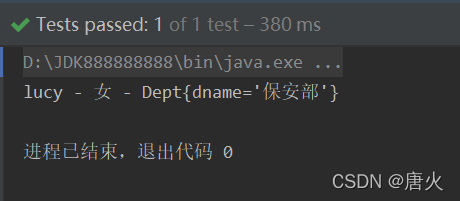xml注入其他属性
bean:
package com.atguigu.spring;/*** 演示使用set方法进行注入属性*/
public class Book {private String bname;private String bauthor;private String address;public Book(String address) {this.address = address;}public String getBname() {return bname;}public void setBname(String bname) {this.bname = bname;}public String getBauthor() {return bauthor;}public void setBauthor(String bauthor) {this.bauthor = bauthor;}public void testDemo(){System.out.println(bname + "::" + bauthor+"::"+address);}
}1.字面量
(1)null值
<bean id = "book" class = "com.atguigu.spring.Book"><!--使用property完成属性注入name:类里面属性名称value:向属性注入的值--><property name="bname" value="易筋经"></property><property name="bauthor" value="达摩老祖"></property><!--null值--><property name="address" ><null/></property></bean>
(2)属性值包含特殊符号
<bean id = "book" class = "com.atguigu.spring.Book"><!--使用property完成属性注入name:类里面属性名称value:向属性注入的值--><property name="bname" value="易筋经"></property><property name="bauthor" value="达摩老祖"></property><!--属性值包含特殊符号1.把<>进行转义,<>2.把带特殊符号内容写到CDATA<![CDATA[你要写入的值]]]>--><property name="address" ><value><![CDATA[<<南京>>]]></value></property></bean>
测试结果:

注入属性-外部bean
(1)创建两个类service类和dao类
(2)在service调用dao里面的方法
package com.atguigu.service;import com.atguigu.dao.UserDao;
import com.atguigu.dao.UserDaoImpl;public class UserService {//spring方法//创建UserDao类型属性,生成set方法private UserDao userDao;public void setUserDao(UserDao userDao){this.userDao = userDao;}public void add01(){System.out.println("service add");userDao.update();}public void add(){System.out.println("service add");//传统方法//创建UserDao对象UserDao userDao = new UserDaoImpl();userDao.update();}
}package com.atguigu.dao;public interface UserDao {public void update();}package com.atguigu.dao;public class UserDaoImpl implements UserDao{@Overridepublic void update() {System.out.println("dao update");}
}(3)在spring配置文件中进行配置
<?xml version="1.0" encoding="UTF-8"?>
<beans xmlns="http://www.springframework.org/schema/beans"xmlns:xsi="http://www.w3.org/2001/XMLSchema-instance"xsi:schemaLocation="http://www.springframework.org/schema/beans http://www.springframework.org/schema/beans/spring-beans.xsd"><!--1.service和dao对象创建--><bean id = "userService" class = "com.atguigu.service.UserService"><!--注入userDao对象name属性值:类里面属性名称ref属性:创建userDao对象bean标签id值--><property name="userDao" ref = "userDaoImpl"></property></bean><bean id = "userDaoImpl" class = "com.atguigu.dao.UserDaoImpl"></bean></beans>
测试:
package com.atguigu.test;import com.atguigu.service.UserService;
import com.atguigu.spring.Orders;
import org.junit.Test;
import org.springframework.context.ApplicationContext;
import org.springframework.context.support.ClassPathXmlApplicationContext;public class TestBean {@Testpublic void testBean01(){//1.加载spring配置文件ApplicationContext context = new ClassPathXmlApplicationContext("bean2.xml");//2.获取配置创建的对象UserService userService = context.getBean("userService", UserService.class);userService.add01();}}测试结果:

注入属性-内部bean
(1)一对多关系:部门和员工
一个部门有多个员工,一个员工属于一个部门
部门是一,员工是多
(2)在实体类之间表示一对多关系,员工表示所属部门,使用对象类型属性进行表示
package com.atguigu.bean;public class Dept {private String dname;public void setDname(String dname){this.dname = dname;}@Overridepublic String toString() {return "Dept{" +"dname='" + dname + '\'' +'}';}
}package com.atguigu.bean;public class Emp {private String ename;private String gender;//员工属于某一个部门,使用对象形式表示private Dept dept;public void setDept(Dept dept) {this.dept = dept;}public void setEname(String ename){this.ename = ename;}public void setGender(String gender) {this.gender = gender;}public void add(){System.out.println(ename+" - "+gender+" - "+dept);}}(3)在spring配置文件中进行配置
<?xml version="1.0" encoding="UTF-8"?>
<beans xmlns="http://www.springframework.org/schema/beans"xmlns:xsi="http://www.w3.org/2001/XMLSchema-instance"xsi:schemaLocation="http://www.springframework.org/schema/beans http://www.springframework.org/schema/beans/spring-beans.xsd"><!--内部bean--><bean id = "emp" class = "com.atguigu.bean.Emp"><!--设置两个普通属性--><property name="ename" value="lucy"></property><property name="gender" value="女"></property><!--设置对象类型属性--><property name="dept"><bean id = "dept" class = "com.atguigu.bean.Dept"><property name="dname" value="保安部"></property></bean></property></bean></beans>
测试:
@Testpublic void testBean02(){//1.加载spring配置文件ApplicationContext context = new ClassPathXmlApplicationContext("bean3.xml");//2.获取配置创建的对象Emp emp = context.getBean("emp", Emp.class);emp.add();}

注入属性-级联赋值
(1)第一种写法:
<?xml version="1.0" encoding="UTF-8"?>
<beans xmlns="http://www.springframework.org/schema/beans"xmlns:xsi="http://www.w3.org/2001/XMLSchema-instance"xsi:schemaLocation="http://www.springframework.org/schema/beans http://www.springframework.org/schema/beans/spring-beans.xsd"><bean id = "emp" class = "com.atguigu.bean.Emp"><property name="ename" value="lucy"></property><property name="gender" value="女"></property><property name="dept" ref = "dept"></property></bean><bean id = "dept" class = "com.atguigu.bean.Dept"><property name="dname" value="财务部"></property></bean>
</beans>

(2)第二种写法:
该方法需要get()方法
package com.atguigu.bean;public class Emp {private String ename;private String gender;//生成dept的get方法public Dept getDept() {return dept;}//员工属于某一个部门,使用对象形式表示private Dept dept;public void setDept(Dept dept) {this.dept = dept;}public void setEname(String ename){this.ename = ename;}public void setGender(String gender) {this.gender = gender;}public void add(){System.out.println(ename+" - "+gender+" - "+dept);}}<?xml version="1.0" encoding="UTF-8"?>
<beans xmlns="http://www.springframework.org/schema/beans"xmlns:xsi="http://www.w3.org/2001/XMLSchema-instance"xsi:schemaLocation="http://www.springframework.org/schema/beans http://www.springframework.org/schema/beans/spring-beans.xsd"><bean id = "emp" class = "com.atguigu.bean.Emp"><property name="ename" value="lucy"></property><property name="gender" value="女"></property><property name="dept" ref = "dept"></property><!--需要生成dept的get方法--><property name="dept.dname" value="技术部"></property></bean><bean id = "dept" class = "com.atguigu.bean.Dept"><property name="dname" value="财务部"></property></bean>
</beans>


![[Spring5]IOC容器_Bean管理XML方式_注入集合类型属性](http://pic.xiahunao.cn/[Spring5]IOC容器_Bean管理XML方式_注入集合类型属性)

![[Spring5]IOC容器_Bean管理_工厂Bean](http://pic.xiahunao.cn/[Spring5]IOC容器_Bean管理_工厂Bean)

![[Spring5]IOC容器_Bean管理_bean的作用域和bean的生命周期](http://pic.xiahunao.cn/[Spring5]IOC容器_Bean管理_bean的作用域和bean的生命周期)


![[Spring5]IOC容器_Bean管理XML方式_自动装配](http://pic.xiahunao.cn/[Spring5]IOC容器_Bean管理XML方式_自动装配)

![[Spring5]IOC容器_Bean管理XML方式_外部属性文件](http://pic.xiahunao.cn/[Spring5]IOC容器_Bean管理XML方式_外部属性文件)
![[Spring5]IOC容器_Bean管理注解方式_创建对象](http://pic.xiahunao.cn/[Spring5]IOC容器_Bean管理注解方式_创建对象)

![[Spring5]IOC容器_Bean管理注解方式_组件扫描配置细节](http://pic.xiahunao.cn/[Spring5]IOC容器_Bean管理注解方式_组件扫描配置细节)

![[Spring5]IOC容器_Bean管理注解方式_注入属性@Autowired_@Qualified_@Resource_@Value](http://pic.xiahunao.cn/[Spring5]IOC容器_Bean管理注解方式_注入属性@Autowired_@Qualified_@Resource_@Value)
)

![[Spring5]IOC容器_Bean管理注解方式_完全注解开发](http://pic.xiahunao.cn/[Spring5]IOC容器_Bean管理注解方式_完全注解开发)
